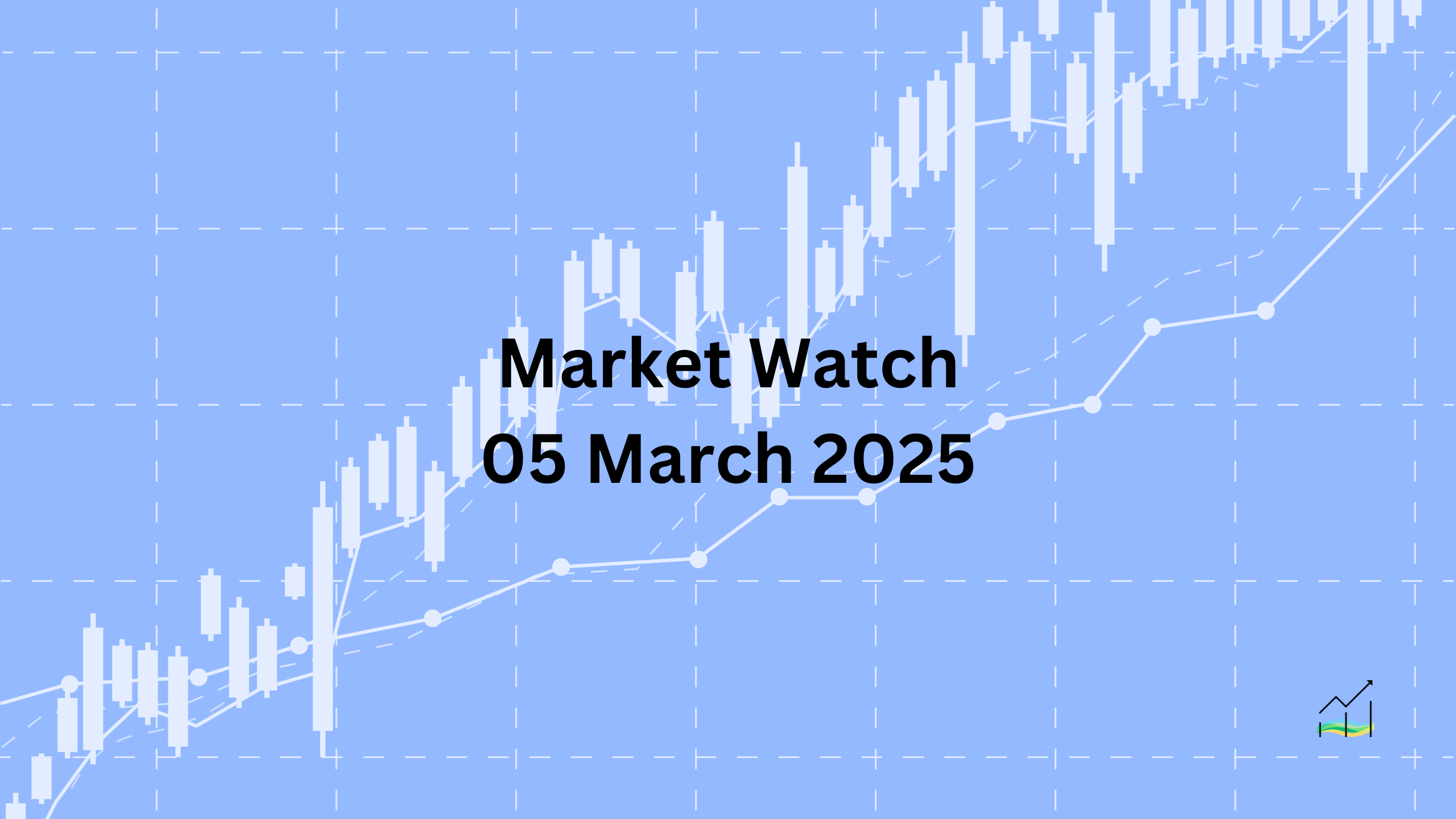05/03/2025 Market Watch

Market Rebounds as U.S. & European Developments Unfold
US equities faced sharp losses amid recession fears and tariff concerns, but the market appears to be recovering. Commerce Secretary Lutnick suggested that President Trump might consider a compromise on the newly announced Mexico and Canadian tariffs, though no such indication was present in his address to Congress. US index futures are currently trading 0.6%-0.8% higher.
Meanwhile, Europe is taking steps to support economic growth. Germany is considering a €500 billion spending program over the next decade, while the EU is discussing fiscal flexibility worth up to €650 billion over four years. However, the idea of joint bonds appears less likely than it seemed weeks ago. The news has triggered a sharp sell-off in European bonds, with benchmark 10-year yields rising by 14-18 basis points. The euro briefly pushed above $1.07, while sterling traded above $1.2850. The US dollar is weaker against most G10 and emerging market currencies, with dollar-bloc currencies underperforming.
Equities are showing strong gains following the recent downturn. Most Asia-Pacific markets rallied, except for Australia and New Zealand, with Hong Kong’s Hang Seng surging 2.8% and mainland shares listed there jumping 3.1%. Europe’s Stoxx 600, which dropped 2.1% yesterday, is now up 1.5% and higher on the week. US index futures are also rebounding.
Gold is consolidating between $2,902 and $2,922 after reaching a high near $2,928 yesterday. April WTI crude oil rebounded from nearly $66.75 to $68.50 but is facing renewed pressure, trading slightly above $67 in late European morning turnover.
United States of America
Overview
The Dollar Index has fallen sharply after initially showing signs of forming a bottom. A combination of US recession fears and a surge in European interest rates has accelerated the decline. The index broke below the 50% retracement level of its October-to-mid-January rally (~105.15) and the 200-day moving average (~105.00) for the first time since November. The next key retracement level (61.8%) is near 104.00.
Despite concerns, economic data suggests that fears of a sharp downturn may be overblown. The latest auto sales data and above-50 readings in PMI and ISM manufacturing indicate that while the economy is cooling, the extent remains uncertain.
Economic Drivers
Recession concerns continue to weigh on the markets, but some indicators suggest that the growth scare may be exaggerated. The Atlanta Fed’s GDP tracker now projects a contraction of -2.8%, yet other data points—such as steady auto sales and manufacturing surveys—paint a less dire picture. Additionally, fiscal policy remains a concern, with tariffs creating uncertainty and a potential government shutdown looming next week.
Data and Events
Key economic reports today include the ADP private sector jobs estimate and the ISM services index, both of which are expected to influence market sentiment. The Fed’s Beige Book, which Chair Powell has previously referenced, could also provide valuable insight into economic conditions.
ADP estimated that the private sector added around 144,000 jobs per month in 2024, while the Bureau of Labor Statistics (BLS) reported an average of 129,000. These figures suggest that the job market remains stable, countering narratives of significant data manipulation or political influence.
Price Action
The Dollar Index has dropped below critical technical levels, breaking through the 200-day moving average. The next major support is near 104.00, which represents the 61.8% retracement level. Market movements are largely being driven by shifting expectations around US growth and monetary policy.
Key Points:
- The Dollar Index has broken key support levels, now targeting 104.00.
- US recession fears and higher European interest rates are driving the decline.
- Economic data remains mixed, with auto sales and manufacturing surveys suggesting some resilience.
- The ADP private sector jobs estimate and ISM services index are key reports to watch.
- Fiscal concerns remain, with tariffs and a possible government shutdown adding uncertainty.
Australia & New Zealand
Overview
The Australian dollar (AUD) has demonstrated a notable recovery this week, overcoming earlier lows and signaling a potential shift in market sentiment. This resurgence occurred amidst a backdrop of key economic data releases and a significant leadership change in New Zealand's central bank. Let's delve into the factors driving this movement and what they signify for the AUD's near-term outlook.
Economic Drivers
Australia's economic performance remains a key driver for the AUD. The latest Q4 2024 GDP figures revealed a 0.6% quarterly expansion, aligning with market expectations and marking the fastest growth rate of the year. This brings the year-over-year growth to approximately 1.3%, with projections indicating a potential acceleration in the coming year. The Reserve Bank of Australia (RBA) and the International Monetary Fund (IMF) both anticipate growth around 2.1% for the year, while consensus estimates hover near 1.9%. These figures suggest a resilient Australian economy, which is crucial for supporting the AUD.
Additionally, the unexpected resignation of Adrian Orr, Governor of the Reserve Bank of New Zealand (RBNZ), at the end of the month, raised some eyebrows. However, the market reaction was muted, indicating that the news did not significantly disrupt prevailing trends.
Data and Events
The week featured several key data releases that influenced market sentiment. The final Australian service and composite Purchasing Managers' Index (PMI) figures were released, with the composite PMI revised downward to 50.6 from the preliminary 51.2 (51.1 in January). This marked the first decline since last September. However, these PMI figures were largely overshadowed by the highly anticipated Q4 2024 GDP data.
The 0.6% quarterly GDP growth, meeting expectations, provided a positive signal for the Australian economy. This data point became the focal point, reinforcing the nation's economic resilience
Price Action
The AUD experienced a significant recovery, taking most of yesterday to surpass Monday's high of approximately $0.6255 and reaching nearly $0.6290 today. This upward momentum followed a recovery from a four-week low near $0.6185 earlier in the week. The successful breach of Monday’s high resulted in a potentially bullish outside up day formation. A move above the $0.6300-25 level is now seen as critical, as it would further bolster the technical outlook for the AUD.
Key Points:
- The Australian dollar has rebounded from recent lows, signaling a potential shift in market sentiment.
- Australia's Q4 2024 GDP growth of 0.6% met expectations and highlighted the economy's resilience.
- A move above $0.6300-25 is crucial for reinforcing the bullish technical tone.
- Projections indicate continued economic growth for Australia, supporting the AUD.
- The resignation of the RBNZ Governor had a minimal impact on the markets.
- Composite PMI was revised lower, but the GDP data took center stage.
Canada
Overview
The Canadian dollar (CAD) has navigated a turbulent week, marked by significant fluctuations against the US dollar (USD) and the looming threat of US tariffs. Despite being the weakest performer among G10 currencies this year, the CAD has shown remarkable resilience in the face of potential economic shocks. The market is keenly watching for any developments regarding US trade policies, which are poised to significantly impact the Canadian economy.
Economic Drivers
The primary economic driver affecting the CAD is the potential imposition of US tariffs. While not all threatened tariffs would apply to Canada (semiconductor chips being a notable exception), the overall uncertainty is already weighing on the Canadian economy. This threat has introduced significant downside risks, particularly as the economy was already showing signs of slowing.
Adding to the economic landscape is the Bank of Canada's (BOC) monetary policy. The BOC initiated policy easing in June 2024, cutting its overnight lending target by 175 basis points last year, with aggressive cuts in Q4 2024. A further quarter-point cut in January signaled ongoing efforts to stimulate the economy. The market's anticipation of further rate cuts is a significant factor in the CAD's valuation.
Data and Events
A key event driving market volatility was the US Commerce Secretary's suggestion of a potential compromise on tariffs, possibly as soon as today. This caused a flurry of market activity. The release of today's services and composite PMI data will be closely monitored, with concerns that the tariff threats may have already negatively impacted these indicators. The upcoming Bank of Canada meeting next week is also a critical event, with market expectations for a rate cut undergoing significant shifts.
Yesterday, the markets discounted a 95% chance of a rate cut. That rate has since scaled back to approximately 65%. Last week the market only gave approximately a 37% chance of a cut. Those shifts in the expected probability create market volatility.
Price Action
The USD/CAD pair experienced significant volatility, holding above CAD1.4400 and peaking near CAD1.4545 in the North American afternoon before reversing to CAD1.4370. This volatility underscores the market's sensitivity to news regarding trade policies and monetary policy. Despite the volatility, the Canadian dollar remains practically flat for the year after the recovery from recent lows.
Key Points:
- Significant fluctuations in the USD/CAD pair reflect market uncertainty.
- US tariff threats are a major economic risk, impacting Canadian economic data.
- Market expectations for BOC rate cuts are highly variable and creating market volatility.
- Canada's economy was already slowing, increasing vulnerability to external shocks.
- Despite challenges, the Canadian dollar has shown notable resilience.
- The next Bank of Canada meeting will be a key event to watch.
China
Overview
China's economic scene is marked by a period of relative stability in the yuan, coupled with cautious trade actions and anticipated policy signals from the National People's Congress. The dollar has remained within a defined trading range against the onshore and offshore yuan, while key economic indicators and trade policies are being closely monitored for future direction.
Economic Drivers
The narrowing yield gap between Chinese and US 10-year bonds, now less than 250 basis points, reflects shifting financial conditions. The impressive performance of mainland shares trading in Hong Kong, up over 18% this year, signals improving market sentiment. These positive financial conditions may prompt Chinese officials to introduce further stimulus measures to support economic growth.
The Chinese government's growth target of around 5% and a CPI target of 2%, announced at the National People's Congress, are central to the nation's economic strategy. Investors are keenly awaiting signals from this event and the Consultative Conference.
Data and Events
China's Caixin services PMI saw a slight improvement to 51.4 from 51.1, while the composite PMI rose to 51.5 from 51.1. This data, although positive, was tempered by the earlier reported rise in the manufacturing PMI. Notably, the composite PMI stood at 52.5 in February 2024.
China's retaliatory measures against US tariffs have been characterized by restraint. The recently announced 15% tariff on select US agricultural goods and limited trade bans on defense companies have been perceived as mild, indicating a desire to maintain dialogue and avoid escalating tensions.
The People's Bank of China (PBOC) set the dollar's reference rate at CNY7.1714 today, marking the second consecutive decline.
Price Action
The dollar has consolidated within a tight range against the offshore yuan (CNH), trading between CNH7.2525 and CNH7.2770 today, remaining within yesterday's range. Over the past three months, the dollar has largely traded between CNH7.22 and CNH7.37. Similarly, against the onshore yuan (CNY), the dollar has traded between CNY7.22 and CNY7.33. This consistent range indicates a period of stability for the yuan.
Key Points:
- The dollar has traded within a narrow range against both onshore and offshore yuan.
- The gap between Chinese and US 10-year bond yields has decreased.
- Hong Kong-traded mainland shares have seen significant gains.
- China has announced growth and CPI targets at the National People's Congress.
- China's retaliatory tariffs have been mild, signaling a cautious approach.
- Service and composite PMI data indicate modest improvements.
- The PBOC has set the reference rate lower for the second day in a row.
Europe
Overview
The euro has experienced a significant recovery in recent weeks, rebounding from a multi-month low and reaching its highest level in nearly four months. This upward trend comes after a substantial decline from late September to early February. The euro's recent performance has been marked by key technical breaches and narrowing yield differentials, signaling a potential shift in market sentiment.
Economic Drivers
A key economic driver is the narrowing yield differential between US and German bonds. The US-German two-year differential, a significant indicator for the EUR/USD exchange rate, has reached a four-month low near 180 basis points. Similarly, the US 10-year premium, which peaked in mid-December, has narrowed to around 153 basis points, its lowest since last September. These narrowing differentials suggest a convergence in monetary policy expectations, which can influence currency valuations.
Data and Events
The euro's recent surge has seen it reach $1.0720, its highest level in nearly four months. This movement has brought it to a critical technical juncture, meeting the 50% retracement of the downtrend that began in Q4 2024, around $1.0675, and testing the 200-day moving average. The next significant retracement level, the 61.8% mark, is near $1.08, which is a key level that traders will watch.
Price Action
After a substantial decline of approximately 9.6% from late September to the February 2 low, the euro has spent the last few weeks consolidating and correcting higher. This correction has culminated in the euro reaching $1.0720 today. The euro has successfully met the 50% retracement level of the Q4 2024 downtrend and tested the 200-day moving average. The next target is the 61.8% retracement near $1.08.
Key Points:
- The euro has risen to a four-month high.
- It reached the 50% retracement level and tested the 200-day moving average.
- US-German yield differentials have significantly narrowed.
- The next key resistance is the 61.8% retracement near $1.08.
- The euro consolidated for several weeks before the recent surge.
- It experienced a decline of approximately 9.6% from late September to February 2nd.
Japan
Overview
The USD/JPY pair is experiencing a period of uncertainty, with the dollar struggling to maintain its footing after an attempted bottoming pattern. The market is closely watching the Bank of Japan's (BOJ) potential policy moves, which are influenced by factors beyond traditional economic indicators like the PMI.
Economic Drivers
The BOJ's policy outlook is a primary driver of the yen's valuation. While the PMI data shows continued improvement in Japan's services and composite sectors, the BOJ appears to place greater emphasis on other factors. The spring wage round, actual inflation performance, and exchange rate movements are likely to have a more significant impact on the BOJ's decisions. The swaps market indicates about a 43% probability of a BOJ rate hike in June, with a full rate hike not priced in until October. This suggests that the market anticipates a gradual tightening of monetary policy.
Data and Events
Japan's final services PMI edged up to 53.7 from the initial 53.1 and January's 53.0, marking the fourth consecutive month of improvement. The composite PMI also rose to 52.0 from the initial 51.1 and January's 50.5. However, these positive PMI figures did not elicit a significant market reaction in Tokyo, reinforcing the notion that the BOJ's focus lies elsewhere.
Price Action
The USD/JPY pair has shown volatility, with the dollar failing to sustain gains in the JPY151.30-50 range, leading to concerns of another downward leg. The pair fell to nearly JPY148 yesterday before recovering to JPY149.50. Today, the pair is trading within a JPY149.10-JPY150.20 range, indicating continued uncertainty. The dollar's inability to break above key resistance levels suggests potential downside risks.
Key Points:
- The dollar failed to sustain gains against the yen, indicating potential downside.
- The BOJ prioritizes wage data, inflation, and exchange rates over PMI.
- Services and composite PMI improved but had minimal market impact.
- Market anticipates a potential BOJ rate hike in June, with a full hike priced in for October.
- USD/JPY is trading within a tight range, reflecting market uncertainty.
- The dollar risks another leg down after stalling in the JPY151.30-50 area.
Switzerland
Overview
Switzerland's economic landscape is marked by exceptionally low inflation and the prospect of a significant interest rate cut. With inflation barely above zero and the Swiss National Bank (SNB) expected to lower deposit rates, the country is navigating a delicate monetary policy environment.
Economic Drivers
The primary driver of the SNB's expected policy decision is the extremely low inflation rate. Switzerland's EU-harmonized Consumer Price Index (CPI) has remained at a mere 0.1% year-over-year since May 2024. This persistently low inflation is prompting the SNB to consider further monetary easing to stimulate the economy.
Data and Events
The key data point is the Swiss EU-harmonized CPI, which stands at 0.1% year-over-year. The Swiss deposit rate is currently at 0.50%. The swaps market is heavily predicting a 25 basis point cut when the SNB meets on March 20th. This potential cut would halve the deposit rate, leaving it precariously close to the zero-bound.
Price Action
While this is not directly related to a traditional price chart, the value of the swiss franc will be affected by the expected rate cut. A rate cut will tend to put downward pressure on the swiss franc. The market pricing of the rate cut, through the swaps market, is the price action in this case. The expectation of a rate cut is fully priced in.
Key Points:
- Switzerland's EU-harmonized CPI is at 0.1%.
- Current Swiss deposit rate is 0.50%.
- Market anticipates a 25 basis point rate cut on March 20th.
- Rate cut will leave little room before the zero-bound.
- The rate cut is already priced into the swaps market.
- A rate cut will tend to put downward pressure on the Swiss Franc.
United Kingdom
Overview
Amidst the significant strain in US-European relations, reminiscent of the Suez Crisis, the UK has carved out a distinct role and voice on the global stage. This has been reflected in the strength of sterling, which has achieved notable gains.
Economic Drivers
The UK's economic landscape presents a mixed picture. While the manufacturing PMI remains below the crucial 50-point threshold, indicating contraction, the services sector has maintained its resilience, staying above 50 since October 2023. This divergence highlights the ongoing adjustments within the UK economy. The services sector remaining above 50, is a source of market strength.
Data and Events
Sterling reached approximately $1.2855, its strongest level since mid-November. This movement signifies a significant milestone, particularly as it marks a settlement above the 200-day moving average, which sits around $1.2785. The final composite PMI was recorded at 50.5, unchanged from the preliminary estimate. In February 2024, it was considerably higher at 53.0. The services PMI in February was 51.0, up from 50.8 in January. These numbers when considered against the geopolitical back drop, add strength to the position of the pound sterling. The next retracement level for sterling is near $1.2925.
Price Action
Sterling's recent surge to approximately $1.2855 represents a strong bullish trend. This break above the 200-day moving average signals potential for further upward momentum. The next key resistance level is the 61.8% retracement, near $1.2925.
Key Points:
- The pound reached a multi-month high.
- The UK's global position is strengthening.
- Services PMI remains above the 50 level.
- Sterling settled above the 200-day moving average.
- The next resistance point is near $1.2925.
- Manufacturing and service PMI's show mixed results.
© 2025 SKONE Enterprise (003319453-V). All rights reserved.
The content on this site is for informational purposes only and does not constitute financial advice.


